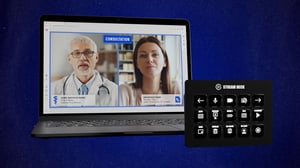
Unleashing the Power of Physical Buttons in Real-Time Communication
In the fast-paced world of real-time communication, efficiency, and seamless interaction are key. While traditional keyboard and mouse inputs have been the norm, a powerful tool has emerged to revolutionize how we control our virtual meetings and live streams: the stream deck.
In my previous article on mastering the Eyeson stream deck plugin I completely oversaw the fact that you might not be acquainted with a Stream Deck. This is why I decided to write a follow-up and explain some of the underlying thoughts.
What is a Stream Deck?
A stream deck, like the popular Elgato Stream Deck, is a physical device with customizable buttons. Each button features a tiny LCD screen displaying icons, text, or even animated graphics. These buttons can be programmed to perform various actions, from simple keystroke combinations to complex macros and even scripts.
The Advantages of Physical Buttons
One might wonder, "Why use physical buttons when keyboard shortcuts exist?" The answer lies in the tangible benefits that a stream deck offers:
Tactile Feedback: Pressing a physical button provides a satisfying tactile response, confirming the action has been triggered. This feedback is especially valuable in high-pressure situations where every second counts.
Visual Cues: The LCD screens on each button serve as visual reminders of the assigned actions. You can quickly identify and execute the desired command with a glance without navigating through menus or remembering complex key combinations. It the functionality is toggled you can even see the state.
Intuitive Organization: Stream decks allow you to group related actions together, creating a logical and intuitive layout. This organization streamlines your workflow and reduces the cognitive load of managing multiple tasks simultaneously.
Flexibility and Customization: Stream decks offer a high degree of customization. You can assign actions, icons, and labels to each button, tailoring the device to your needs. This flexibility enables you to optimize your setup for maximum efficiency.
Enhancing Real-Time Communication with Stream Decks
In the context of real-time communication, stream decks can be game-changers. Here are a few examples of how they can enhance your experience:
Instant Layout Switching: With a single button press, you can switch between different video layouts, adapting to the flow of the conversation or highlighting specific participants.
Seamless Scene Transitions: Transition between different scenes or camera angles effortlessly, ensuring a polished and professional presentation.
Engaging Interactions: Trigger interactive elements like polls, Q&A sessions, or even virtual applause to foster audience engagement and participation.
Real-Time Adjustments: Quickly mute or unmute participants, adjust audio levels, or toggle screen sharing without disrupting the meeting flow.
While stream decks are often associated with professional streamers and content creators, their benefits extend to anyone involved in real-time communication. Whether you're conducting virtual meetings, webinars, or remote collaboration sessions, a stream deck can significantly enhance your productivity and overall experience.
Conclusion
The power of physical buttons in real-time communication cannot be understated. Stream decks, like the Elgato Stream Deck, offer a tactile, visual, and intuitive way to control your virtual interactions. By leveraging the advantages of physical buttons and customizable layouts, you can streamline your workflow, enhance your presentations, and create engaging experiences for your audience.
So, whether you're a seasoned professional or just starting to explore the world of real-time communication, consider adding a stream deck to your toolkit. Embrace the power of physical buttons and unlock a new level of efficiency and control in virtual interactions.